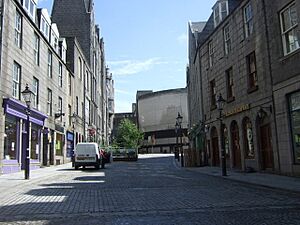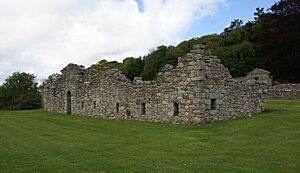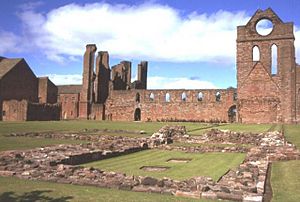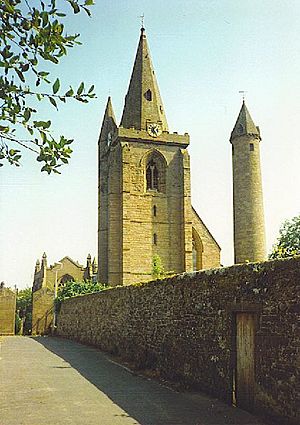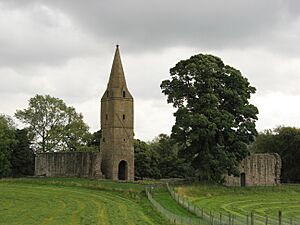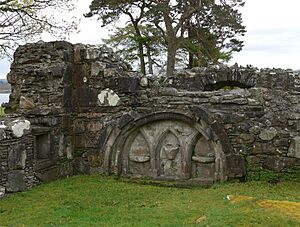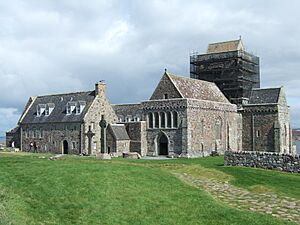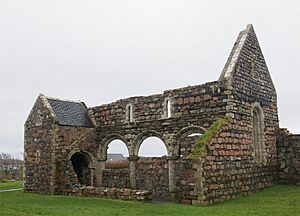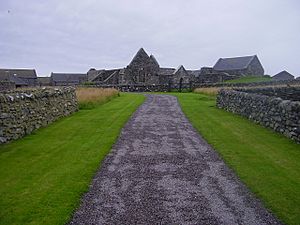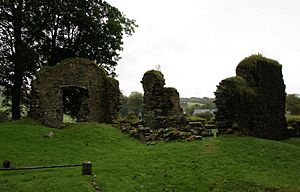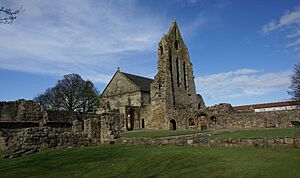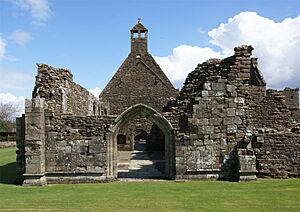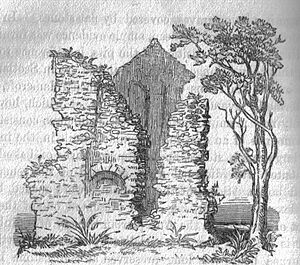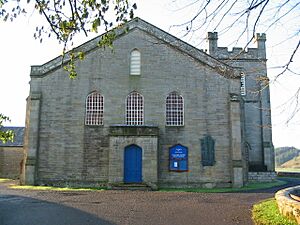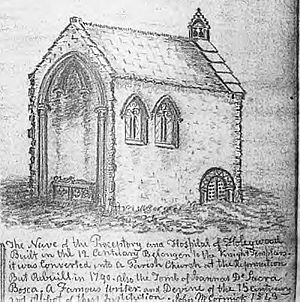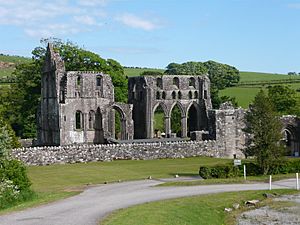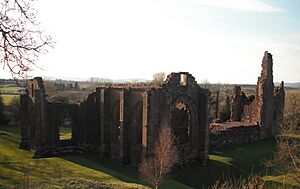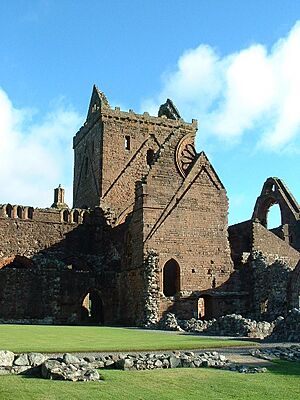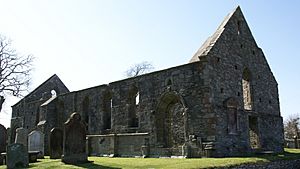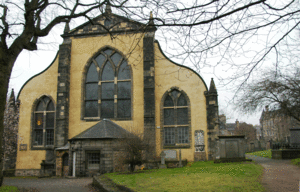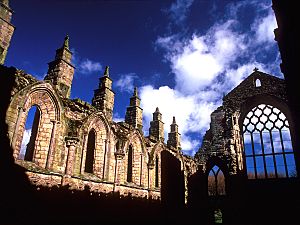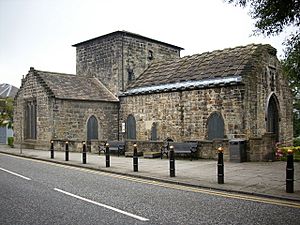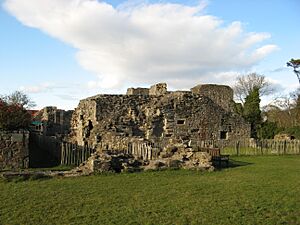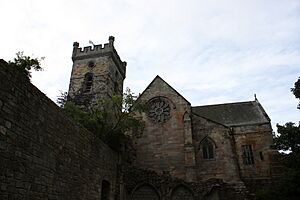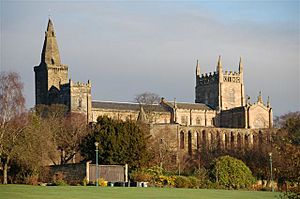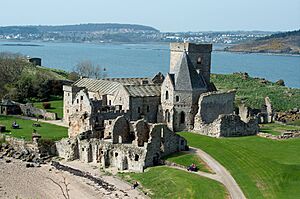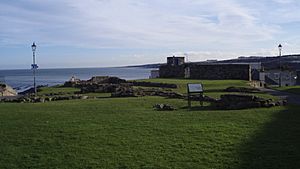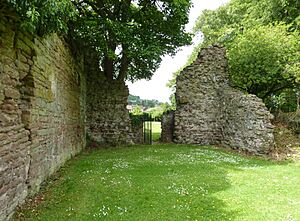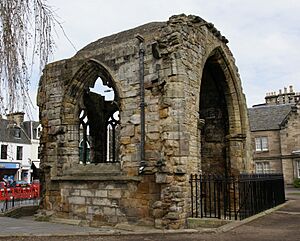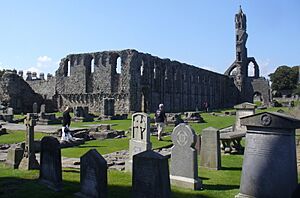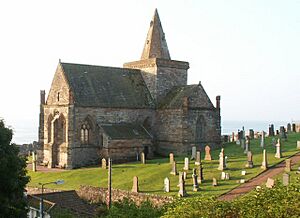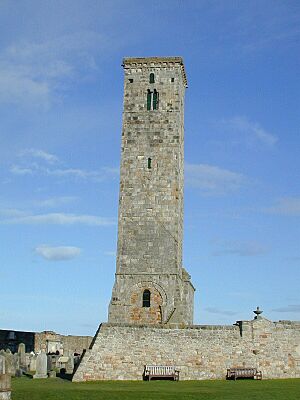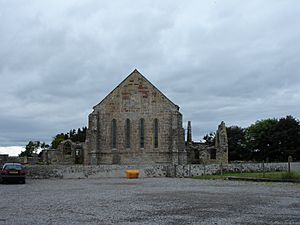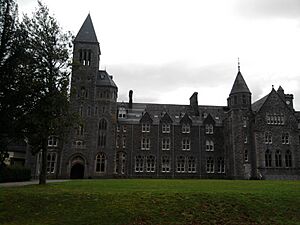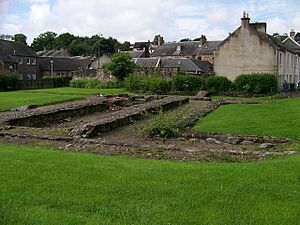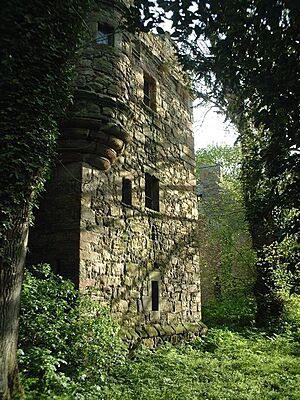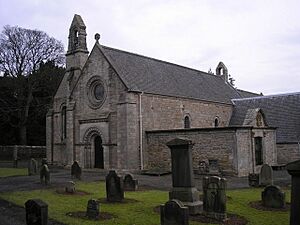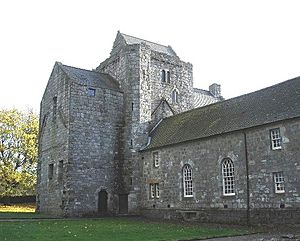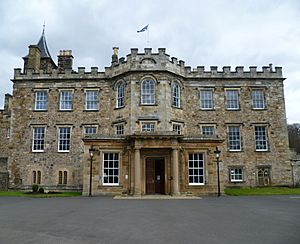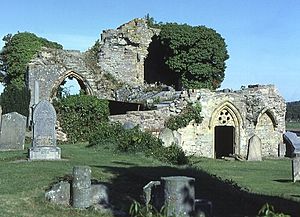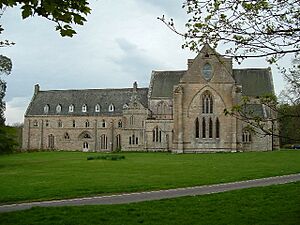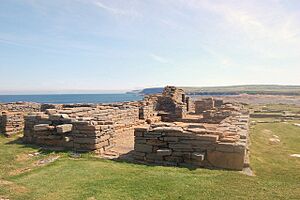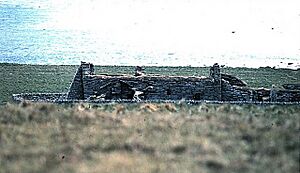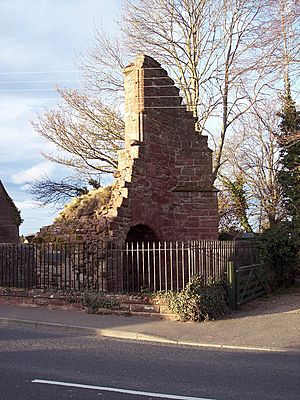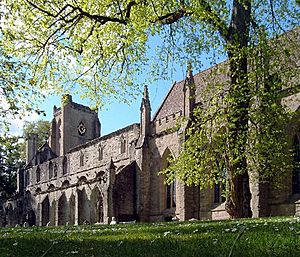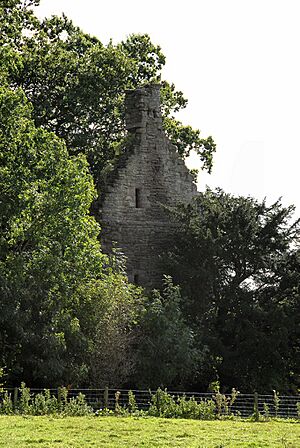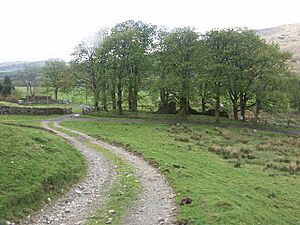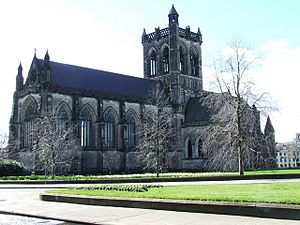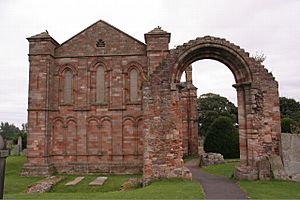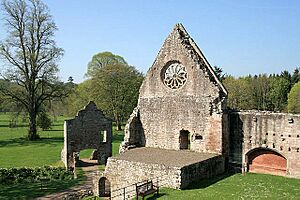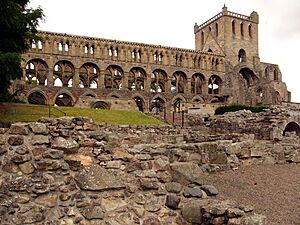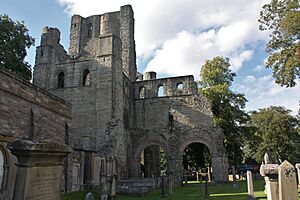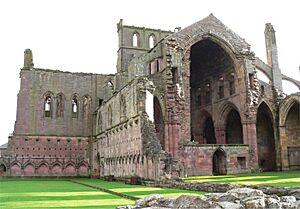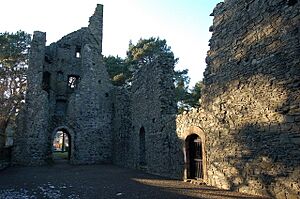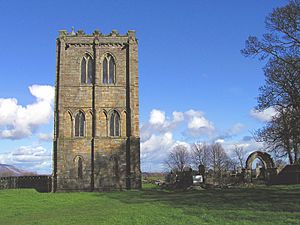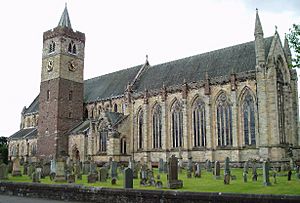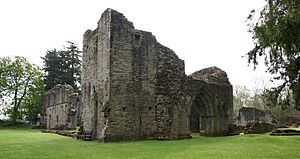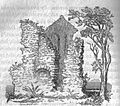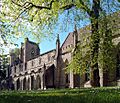List of monastic houses in Scotland facts for kids
This article lists the different types of monastic houses in Scotland. These are places where groups of religious people, like monks, nuns, or friars, lived and prayed together. They include large abbeys and smaller priories or friaries.
You'll also find some smaller places like cells (small communities) and special monastic granges (farmhouses with monks). However, most monastic hospitals aren't included unless they also served as an abbey, priory, friary, or preceptory (a type of religious military house).
The locations mentioned here come from the Royal Commission on the Ancient and Historical Monuments in Scotland (RCAHMS) and Ordnance Survey maps.
Contents
|
Understanding This List
How the List is Organized
This list is set up alphabetically by the different regions in Scotland. Within each region, the monastic houses are also listed in alphabetical order.
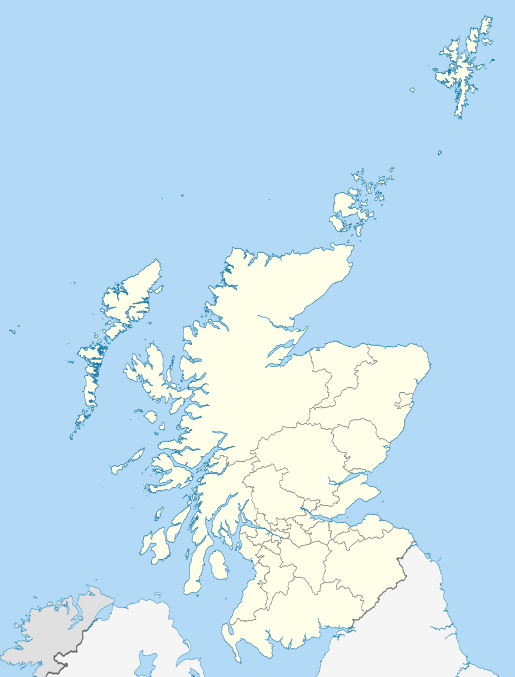
- Communities/provenance: This tells you what kind of religious group lived there (like monks or nuns), when the place was started, what happened to it after the monasteries were closed down, and what the site looks like today.
- Formal name or dedication: This is the official name of the place or the saint it was named after.
- Alternative names: Some places had different names over time, or their names were spelled differently. These are included to help you find them.
What the Symbols Mean
| * | This means the place is still used as a monastery today. |
|---|---|
| + | This means the place is now used for a non-monastic church purpose, or parts of it are in a later building. |
| ^ | This means the place is now used for something non-religious, or parts of it are in a later building. |
| $ | This means only traces like earthworks (changes in the ground) are left. |
| # | This means there's no clear sign of the original monastic building left. |
| ~ | This means the exact location of the monastery is unknown. |
If a name is in italics, it might mean it's a mistake, a duplicate entry, or a place that was planned but never built.
| HES | Historic Environment Scotland |
| NTS | National Trust for Scotland |
| CS | Church of Scotland |
Monastic Houses by Region
Aberdeen
| Foundation | Image | Communities & provenance | Formal name or dedication & alternative names |
Online references & location |
|---|---|---|---|---|
| Aberdeen Blackfriars | Dominican Friars (a group of monks) Started between 1230 and 1249, possibly by King Alexander II. Destroyed by reformers in 1560. The land was given to George, Earl Marischal, in 1587. Today, Robert Gordon's College stands on this site. |
St John the Baptist | ||
| Aberdeen Greyfriars | Observant Franciscan Friars (another group of monks) Started in 1469. The friars gave their property to the Town Council in 1559. King James VI gave it to the Town Council in 1567 to be a hospital. The church was used by the local community until 1903. |
57°08′58″N 2°05′48″W / 57.1494178°N 2.0966506°W |
||
| Aberdeen Monastery | Benedictine monks (a very old group of monks) Thought to have been started before 1231. It's possible no monastery was actually built here. |
|||
| Aberdeen Nunnery | Supposedly a place for nuns (religious women). However, there is no real proof that such a place existed. |
St Catherine | ||
| Aberdeen Preceptory | This was property of the Knights Templars, but the idea of it being a "convent and church" is not true. | |||
| Aberdeen Red Friars | Trinitarians (a group of friars) Started before 1274 (possibly 1181). King William the Lion is said to have given his royal home to two Red Friars in 1211. Closed in 1561. |
The Church of the Holy Trinity, Aberdeen | 57°08′44″N 2°05′47″W / 57.1454601°N 2.096318°W |
|
| Aberdeen Whitefriars | Carmelite Friars (another group of friars) Started around 1273. Closed between 1560 and 1583. King James VI gave the land to the Town Council in 1583. |
57°08′44″N 2°05′57″W / 57.1455183°N 2.0991075°W |
||
Aberdeenshire
| Foundation | Image | Communities and provenance | Formal name or dedication and alternative names | References and location |
|---|---|---|---|---|
| Aberdour Monastery | Celtic monks (early Christian monks in Scotland) Stories say it was started by Colum Cille and Drostan mac Coscrach. However, this is likely not true. |
|||
| Aberdour Priory | Franciscan nuns (religious women) Started in 1548 by James, Earl of Morton. Closed in 1560. |
Aberdene Priory (this name is wrong) | ||
| Aboyne Preceptory | Knights Templar (a military religious order) A church was given to them. This is thought to be a supposed house, meaning it might not have been a full monastic house. |
|||
| Banff Greyfriars | Supposedly Franciscan Friars Minor, Conventual (a group of monks). This might be a mix-up with another Carmelite house. |
St John | ||
| Banff Whitefriars | Carmelite Friars Started between 1321 and 1324 by King Robert I. Burned down in 1559. Closed or taken over by the government in 1574. King James VI gave it to King's College, Aberdeen in 1574. |
Priory of Bethlem of ye ordour of Carmelits beside Banff | 57°39′15″N 2°32′10″W / 57.6541202°N 2.536212°W |
|
| Buchan Priory | A grant was made to canons (religious priests) in Buchan in 1221. However, there's no known monastic house for canons in Buchan, Aberdeenshire. This might be a mistake or refer to a place outside Scotland. |
|||
| Clova Monastery | Celtic monks Part of Mortlach. Started before 1157. Confirmed by Pope Adrian IV. |
Clovett Monastery; St Luke's Chapel |
57°16′43″N 2°54′15″W / 57.2785491°N 2.9041648°W |
|
| Deer Abbey | Celtic monks Stories say it was started in the 6th century by Colum Cille, but this is not certain. Cistercian monks (a group of monks) Started between 1214 and 1219. Closed in 1560. The land became a lordship for Robert Keith. (HS) |
The Abbey Church of Saint Mary, Deer | 57°31′24″N 2°3′14.5″W / 57.52333°N 2.054028°W |
|
| Drumtochty Whitefriars | Land was given to the Carmelite Friars of Aberdeen in 1403. However, no actual monastery was built here. |
|||
| Dunet Red Friars | Supposedly Trinitarians Said to have been started in 1297. This is likely a made-up house. |
Dumeni; Dunetum; Dumenum |
||
| Ecclesgreig Monastery | Celtic monks The church of Ecclesgyrg was given to St Andrews between 1189 and 1195. |
|||
| Forvie Preceptory | Supposedly Knights Templar property. King's College was described as a former Templars' house. |
|||
| Fyvie Priory | Tironensian monks (a group of monks) Part of Arbroath. Started in or before 1285. Joined with Arbroath Abbey in 1459. Its closing date is unknown, but it might have lasted until the Reformation. |
The Priory Church of The Blessed Virgin Mary and All Saints, Fyvie | 57°25′47″N 2°23′35″W / 57.4296817°N 2.3931742°W |
|
| Kennethmont Cell | Supposedly a small community of monks that burned down during the Reformation. It was a parish church, and there's no proof it was a monastery. |
|||
| Monymusk Priory | Culdees (early Scottish religious group) Started in 1138. Refounded around 1245 as Augustinian Canons Regular (a group of religious priests). Closed in 1617. |
The Priory Church of Saint Mary and Saint John, Monymusk ____________________ erroneously Monymaill in Fyfe |
57°13′38″N 2°31′21″W / 57.227149°N 2.5224674°W |
|
| Mortlach Monastery | This was an early site for the bishopric (area looked after by a bishop) of Aberdeen. | |||
| Tullich Preceptory | Knights Templar It was a parish church owned by the Templars, not a monastic house. |
|||
| Turriff Monastery | Celtic monks Started before 1131. Closed after around 1150. |
St Congan's Church | 57°32′16″N 2°27′56″W / 57.5377583°N 2.465567°W |
|
Angus
| Foundation | Image | Communities & provenance | Formal name or dedication & alternative names |
Online references & location |
|---|---|---|---|---|
| Arbroath Abbey | Tironensian monks from Kelso Abbey. Started in 1176 (or 1178) by William the Lion. The church was officially named in 1233. Damaged by lightning in 1380. Closed in 1606. |
The Abbey Church of Saint Thomas of Canterbury, Arbroath | 56°33′45″N 2°34′56″W / 56.56250°N 2.58222°W |
|
| Barry Red Friars | Supposedly Trinitarians Said to have been started in 1212 by William the Lion and built by Alexander II. This is a fictional house. |
domus Barensis | ||
| Brechin Monastery | Culdees Probably started before 975. The site is now home to Brechin Cathedral, which is a Church of Scotland congregation. |
56°43′51″N 2°39′41″W / 56.730732°N 2.6615077°W |
||
| Brechin Red Friars | Trinitarians Said to have been started in 1256 or around 1258. However, there's no strong proof for this. |
|||
| Brechin Whitefriars? | Supposedly Carmelite Friars Said to have been started in 1376. This foundation is not proven. |
|||
| Dundee Blackfriars | Dominican Friars Started around 1521. Attacked by a mob in 1543. Probably destroyed in 1548 when the English burned the town. |
dedication unknown | 56°27′39″N 2°58′25″W / 56.4608611°N 2.9737222°W |
|
| Dundee Greyfriars | Franciscan Friars Minor, Conventual Started before 1289. Built before 1296. Closed around 1560. |
56°27′40″N 2°58′22″W / 56.4610849°N 2.9727888°W |
||
| Dundee Priory | Franciscan nuns Started in 1501 or 1502. Closed in 1560, and the local leaders of Dundee took possession in 1567. |
|||
| Dundee Red Friars | Supposedly Trinitarians Said to have been started in 1283. This was probably a hospital, and the idea of it being a monastic house is likely wrong. |
|||
| Kettins Red Friars | Supposedly Trinitarians This was a parish church, not a Trinitarian house. |
Katnes; Ketnes |
||
| Monifieth Monastery | Culdees Started in the 12th century. Closed by around 1220. |
56°28′50″N 2°49′16″W / 56.4804939°N 2.8211716°W |
||
| Restenneth Priory | Possibly an early foundation built around 710. Augustinian Canons Regular Started between 1161 and 1162. Closed in 1606. |
St Peter ____________________ Restennet Priory; Rostin Priory; Rostinoth Priory; Roslin Priory (this name is wrong) |
56°39′12″N 2°50′46″W / 56.6532778°N 2.846092°W |
|
The following location in Angus has no monastic connection:
- Rossie Priory: This is a large house built in 1807, not a monastery.
Argyll & Bute
| Foundation | Image | Communities & provenance | Formal name or dedication & alternative names |
Online references & location |
|---|---|---|---|---|
| Artchain Monastery, Tiree |
Celtic monks Thought to have been started in the 6th century. |
|||
| Ardchattan Priory | Celtic monks Started by Findchan. Later, Valliscaulian monks (a group of monks) from Val des Choux started a new community in 1230 or 1231. Part of the church was used by the local community until 1722. Today, a Victorian house stands on much of the site. (HS) |
The Priory Church of Saint John the Baptist, Ardchattan | 56°27′47″N 5°17′38″W / 56.4630269°N 5.2938706°W |
|
| Bledach Monastery, Tiree |
Celtic monks Started before 577 by Brendan. |
|||
| Cara Red Friars | Supposedly Trinitarians Said to be a small community. It was only a chapel, not a Trinitarian monastery. |
St Fionnlugh's Chapel | 55°38′06″N 5°44′58″W / 55.6350576°N 5.7495447°W |
|
| Cella Diuni, Loch Awe | Celtic monks Possibly started by Diun. |
St Columba's Church; Kilneuair |
56°10′44″N 5°24′09″W / 56.1788498°N 5.4024429°W |
|
| Colonsay Abbey | Supposedly Augustinian Canons Regular Said to be an abbey, but there's no proof of a monastic house here. |
|||
| Garvellach Islands Monastery | Stories say it was started in the late 6th century by Brendan. Probably located on the island of Eileach an Naoimh. |
Ailech Monastery Eileach-an-Naoimh Monastery |
||
| Hinba Monastery | Celtic monks Started before 597 by Colum Cille, probably on the island of Jura. |
possibly Jura Monastery (see below) | ||
| Inchkenneth Monastery ? | Supposedly a monastery, but the island was owned by Iona Nunnery. Only a parish church is proven to have been here. |
|||
| Inchmarnock Monastery | Supposedly a small community of monks. It was only a parish church, and there's no proof of a monastery. |
Inchmernock | ||
| Inishail Priory | Supposedly Cistercian nuns The remains of a building were thought to be a nunnery. It was actually a parish church. This supposed priory is not real. |
|||
| Iona Abbey + | Celtic monks Started around 565 by Colum Cille. Attacked by Vikings in 795 and 802. Benedictine monks An abbey was started in 1203. Closed around 1587 or 1588. Today, it is restored and used as a Christian community. (HS) |
56°20′02″N 6°23′36″W / 56.333967°N 6.393249°W |
||
| Iona Priory | Augustinian Canonesses (religious women) Started before 1208, possibly by Ragnall mac Somairle. Closed after 1574. (HS) |
St Mary ____________________ Iona Nunnery |
56°19′50″N 6°23′36″W / 56.3305232°N 6.3932168°W | |
| Jura Monastery | Possibly the same as Hinba Monastery. | Hinba Monastery? (see above) | ||
| Kerrara Priory | Supposedly Cistercian monks A monastery was planned after 1292 but never built. There's no proof of monks living on the island. |
|||
| Kingarth Monastery | Celtic monks Started in the 6th century, supposedly by St Blane. It was also the seat of a bishop. (HS) |
Cinngrad Monastery | 55°44′13″N 5°02′10″W / 55.7368348°N 5.0360084°W |
|
| Lismore Monastery | Started before 592 by Lugaid or Moluag. | |||
| Mag Luinge, Tiree | Started before 597, probably at Soroby. Destroyed by fire in 673 but later rebuilt. |
|||
| Oronsay Priory | Augustinian Canons Regular Started before 1353 (or 1330). Closed or taken over by the government in 1617. King James VI gave the land to the Bishop of the Isles in 1616. |
The Priory Church of Saint Oran, Oronsay | 56°01′12″N 6°15′17″W / 56.019902°N 6.25467°W |
|
| Rothesay Abbey | A ruined church sometimes called St Mary's Abbey. It was a medieval parish church, not a monastery. |
'St Mary' | ||
| Saddell Abbey | Cistercian monks from Mellifont in Ireland. Started before 1207 by Reginald, son of Somerled. Closed around 1507. King James VI confirmed it to the Bishop in 1507. |
55°31′56″N 5°30′40″W / 55.532163°N 5.5111939°W |
||
| Sgòr Nam Ban-Naomha Monastery | ||||
| Texa Cell | Supposedly a small community of monks There is evidence of a church, but the idea of it being a monastic cell is not true. |
Helentexa | ||
| Tiree Monastery | Started around 564-565 by Comgall. Soon abandoned because of attacks by the Picts. |
56°30′01″N 6°54′34″W / 56.5002062°N 6.9093651°W |
Ayrshire
East Ayrshire
| Foundation | Image | Communities & provenance | Formal name or dedication & alternative names |
Online references & location |
|---|---|---|---|---|
| Mauchline Priory | Cistercian monks A farm or small community of Melrose. Started in 1165, supposedly by King David I. |
The Priory Church of Saint Cuthbert, Mauchline |
North Ayrshire
| Foundation | Image | Communities & provenance | Formal name or dedication & alternative names |
Online references & location |
|---|---|---|---|---|
| Fintray Priory | Supposedly a house of Tironensian monks Said to be built around 1386, but it's now known to be imaginary. |
|||
| Holy Island | Supposedly a monastery started by Ranald, King of the Isles and Argyll. The island was owned by Iona. There's no proof of a monastery here. |
|||
| Irvine Whitefriars | Carmelite Friars Probably started before 1293. Closed or taken over by the government in 1572. King James VI gave it to the Royal School of Irvine in 1572. |
55°36′46″N 4°40′25″W / 55.612693°N 4.6736814°W |
||
| Kilwinning Abbey | Tironensian monks from Kelso. Started between 1162 and 1189. Closed in 1592. |
The Abbey Church of the Blessed Virgin Mary, and Saint Winning, Kilwinning | 55°39′12″N 4°41′55″W / 55.6534215°N 4.6986508°W |
|
| Kilwinning Convent | Located at Stanecastle and mentioned in old documents. | |||
| Southannan Priory | Franciscan nuns Said to have been destroyed at the Reformation. This is a supposed foundation with no real proof. Only a chapel and a graveyard were mentioned at the site. |
Ayrshire, North Non-Christian Monasteries
| Foundation | Image | Communities & provenance | Formal name or dedication & alternative names |
Online references & location |
|---|---|---|---|---|
| Holy Island Monastery | Tibetan Buddhist (a non-Christian religious community) This is a modern monastery. |
South Ayrshire
| Foundation | Image | Communities & provenance | Formal name or dedication & alternative names |
Online references & location |
|---|---|---|---|---|
| Ayr Blackfriars | Dominican Friars Started before 1242 (or 1230) by King Alexander II. Closed in 1567, and the land was given to the Burgh of Ayr. Torn down after the Reformation. |
The Friary Church of Saint Katherine, Ayr | ||
| Ayr Greyfriars | Observant Franciscan Friars Started in 1474 (or between 1488 and 1497). Closed in 1567. |
St John the Baptist ____________________ Auld Kirk of Ayr |
55°27′46″N 4°37′43″W / 55.4627865°N 4.6287096°W |
|
| Crossraguel Abbey | Cluniac monks (a group of monks) A small chapel was started before 1214-16. Became an abbey before 1270. Closed in 1617. (HS) |
The Abbey Church of Saint Mary, Crossraguel | 57°08′55″N 4°43′16″W / 57.148603°N 4.720992°W |
|
| Dalmilling Priory | Gilbertine Canons and nuns (a double community of religious men and women) Started between 1219 and 1228. Closed in 1238. |
Dalmulin Priory | 55°20′20″N 4°35′47″W / 55.338825°N 4.5964158°W |
|
| Fail Monastery | Trinitarians Started before 1335. Closed in 1561. |
St Mary ____________________ Failford Abbey; Fail Monastery, Tarbolton |
55°31′34″N 4°30′09″W / 55.5260056°N 4.5025063°W |
|
| Fail Crutched Friars | Supposedly Crutched Friars (a group of friars). This might be a mix-up with the Trinitarian monastery. |
Pful Friary; Phall Friary; Faill Friary; Fayl in Scotia Friary |
||
| Fail Priory | Supposedly Cluniac monks This is probably a mix-up with the Trinitarian monastery. |
Feale Monastery | ||
| Kar Monastery | Order of Vaudey (a group of monks) No records of monks living here. Land was given to Melrose in 1223. Sometimes said to be in Galloway. |
|||
| Ladykirk Preceptory | Supposedly Knights Templar It was a secular chapel (not monastic) started around 1446. The references to it being a preceptory are misleading. |
Our Lady Kirk of Kyle | ||
| Lochfeal Red Friars | Supposedly Trinitarians No such house existed. |
|||
Dumfries and Galloway
| Foundation | Image | Communities & provenance | Formal name or dedication & alternative names |
Online references & location |
|---|---|---|---|---|
| Canonbie Priory | Augustinian Canons Regular Part of Jedburgh. Started between 1165 and 1170. Closed in 1606. |
55°04′25″N 2°56′28″W / 55.0736777°N 2.9410636°W |
||
| Dercongal Abbey | Premonstratensian Canons (a group of religious priests) from Soulseat. Started before 1225. Closed in 1609. |
The Abbey Church of Saint Mary, Holywood ____________________ Holywood Abbey |
55°06′02″N 3°38′24″W / 55.1004623°N 3.639999°W |
|
| Dumfries Blackfriars | Supposedly Dominican Friars This is probably a mistake for the Greyfriars house. |
55°04′03″N 3°36′51″W / 55.0675803°N 3.6140836°W |
||
| Dumfries Greyfriars | Franciscan Friars Minor, Conventual Started before 1266. Closed in 1569. The Town Council took possession by 1570. |
St Mary | ||
| Dundrennan Abbey | Cistercian monks from Rievaulx. Started in 1142 by King David I or Fergus of Galloway. Closed in 1560. (HS) |
The Abbey Church of Saint Mary, Dundrennan | 54°48′24″N 3°56′52″W / 54.806667°N 3.947778°W |
|
| Glenluce Abbey | Cistercian monks from Melrose. Started in 1191 or 1192. Closed in 1560. Given to the Bishop of Galloway in 1619. (HS) |
The Abbey Church of Saint Mary, Glenluce ____________________ Luce Abbey |
54°53′21″N 4°49′53″W / 54.88917°N 4.83139°W |
|
| Hoddam Monastery | Celtic monks Started before 612, possibly by Kentigern. It was said to be the seat of his bishopric. |
55°02′29″N 3°18′17″W / 55.0413151°N 3.3047605°W |
||
| Kar Monastery | This is listed as being in Galloway, but it's probably in South Ayrshire (see above). | |||
| Kilconquhar Monastery | Supposedly Benedictine monks No such place or monastery exists. |
|||
| Kirkcudbright Blackfriars | Dominican Friars This is probably a mistake for the Greyfriars house. |
|||
| Kirkcudbright Greyfriars + | Franciscan Friars Minor, Conventual Started around 1450 (or between 1449 and 1456) by King James II. Closed in 1569. The church was used by the local community from 1570. |
54°50′08″N 4°03′16″W / 54.835636°N 4.0544271°W |
||
| Kirkcudbright Monastery | A group of religious scholars who served a church here. They still owned the church in 1164. |
|||
| Lincluden Priory | Benedictine nuns (religious women) Started in 1164 (or before 1174). Closed in 1389. Later became a college for secular canons (religious priests not living under a monastic rule) in the late 14th century. (HS) |
55°05′04″N 3°37′11″W / 55.0845822°N 3.6197805°W |
||
| Lochkindeloch Priory | Cistercian monks This is a supposed foundation. It was a parish church, but no religious house was in the parish other than Sweetheart Abbey. |
|||
| St Evoca Priory | Cistercian nuns Started before 1423. Its closing date is unknown. |
St Evoca the Virgin | ||
| St Mary's Priory, St Mary's Isle (Isle of Trahil) | Augustinian Canons Regular from Holyrood. Started around 1138 (or before 1173). Closed in 1608. |
Prioratus Sanctae Mariae de Trayl ____________________ St Mary's Isle Priory; Trail Priory; Traill Priory |
54°49′03″N 4°04′03″W / 54.8175028°N 4.067452°W |
|
| Soulseat Abbey | Premonstratensian Canons from Prémontre. Started in 1161 (or 1152). Closed in 1630. |
The Abbey Church of Saint Mary and Saint John, Soulseat ________________ Saulseat Abbey |
54°53′14″N 4°57′45″W / 54.8871452°N 4.9625319°W |
|
| Soulseat Priory | Cistercian monks This foundation is uncertain, and its location is not confirmed. |
Viride Stagnum | ||
| Sweetheart Abbey | Cistercian monks from Dundrennan. Started in 1275 by Devorgilla. Closed in 1565. The land became a lordship in 1624. (HS) |
The Abbey Church of Saint Mary, Sweetheart ____________________ New Abbey |
54°58′44″N 3°36′59″W / 54.97889°N 3.61639°W |
|
| Tongland Abbey | Premonstratensian Canons from Cockersand in Lancashire. Started in 1218. Closed in 1612. |
54°51′47″N 4°01′48″W / 54.8630151°N 4.0300781°W |
||
| Whithorn Priory | Possibly an early Christian community in the late 4th century. Possibly a monastery by the 8th century. Premonstratensian Canons Started around 1175 or before 1161. Closed in 1612. It was also the cathedral church of Galloway. (HS) |
54°44′01″N 4°25′03″W / 54.7334919°N 4.4174695°W |
||
| Wigtown Blackfriars | Dominican Blackfriars Started in 1267 or before 1287. Closed between 1560 and 1570. Probably given to the Burgh of Wigtown. |
The Annunciation of the Blessed Virgin Mary | 54°52′01″N 4°26′31″W / 54.867°N 4.442°W | |
Dumfries and Galloway Non-Christian Monasteries
| Foundation | Image | Communities & provenance | Formal name or dedication & alternative names |
Online references & location |
|---|---|---|---|---|
| Samye Ling Monastery *, Langholm | A Karma Kagyu school Tibetan Buddhist monastery. Started in 1967. It is still active today. |
Kagyu Samye Ling Monastery and Tibetan Centre |
Dunbartonshire
West Dunbartonshire
| Foundation | Image | Communities & provenance | Formal name or dedication & alternative names |
Online references & location |
|---|---|---|---|---|
| Ross Priory, Loch Lomond | This is a doubtful establishment, probably made up in the early 19th century. It's a country house. |
56°03′17″N 4°32′51″W / 56.0546176°N 4.5473957°W |
City of Edinburgh
| Foundation | Image | Communities & provenance | Formal name or dedication & alternative names |
Online references & location |
|---|---|---|---|---|
| Edinburgh Blackfriars | Dominican Friars Started in 1230 by King Alexander II. Closed between 1566 and 1567. The land was given to the magistrates and Edinburgh Town Council. The area is now part of the University of Edinburgh. |
The Assumption of the Blessed Virgin Mary | 55°56′55″N 3°11′05″W / 55.9486231°N 3.1847692°W |
|
| Edinburgh Greenside Whitefriars | Carmelite Friars Started between 1520 and 1525. Closed before 1563. |
55°57′26″N 3°10′58″W / 55.9572621°N 3.182846°W |
||
| Edinburgh Greyfriars | Observant Franciscan Friars Started around 1463. Destroyed by reformers in 1559. Closed in 1562. Greyfriars Tolbooth & Highland Kirk was built on the site between 1602 and 1620. |
55°56′48″N 3°11′32″W / 55.9466°N 3.1922°W | ||
| Edinburgh Preceptory | This was property, said to be a preceptory. | |||
| Edinburgh Sciennes Priory | Dominican nuns Started in 1517. Closed in 1569. |
St Katherine of Senis | 55°56′14″N 3°11′09″W / 55.9373286°N 3.1857536°W |
|
| Holyrood Abbey, Edinburgh | Augustinian Canons Regular from St Andrews. Started in 1128 by King David I. Attacked by the English in 1322 and burned in 1385. Closed in 1606. Part of it was used as a parish church until 1686. It is now partly absorbed into Holyrood Palace. (HS) |
The Abbey Church of Saint Mary, Saint Andrew and All Saints, Holyrood | 55°57′12″N 3°10′16″W / 55.9532246°N 3.1711864°W |
|
| South Queensferry Whitefriars | Carmelite Friars Started in 1440 or 1441. Closed before 1564 or 1565. The land was leased to the Town Council for a church and school. The current church was built on the site in 1635. |
Queensferry Friary | 55°59′27″N 3°23′54″W / 55.9908866°N 3.3982301°W |
|
| Sciennes Priory | Franciscan nuns There are unproven stories about this being a hospital. |
Eilean Siar
| Foundation | Image | Communities & provenance | Formal name or dedication & alternative names |
Online references & location |
|---|---|---|---|---|
| Barra Red Friars | Trinitarians Supposedly a small community. Possibly an old Celtic church. This house is said to exist but lacks proof. |
The Holy Trinity | ||
| Carnish 'Cell' | Supposedly Augustinian Canons Regular Said to be a small community of Inchaffray. There's no proof of a monastic house here. |
Scarinche | ||
| Nuntown Priory | Supposedly nuns of an unknown order. This is probably a false story about a building on Benbecula that locals thought was a nunnery. |
|||
| Rowadil Priory | Supposedly Augustinian Canons Regular Said to be a priory, started by MacLeod of Harris. It was likely just a parish church or chapel. |
Rodwil; Rowadill; Rodel |
Fife
| Foundation | Image | Communities & provenance | Formal name or dedication & alternative names |
Online references & location |
|---|---|---|---|---|
| Balmerino Abbey | Cistercian monks from Melrose. Started around 1227 or 1229. Closed in 1560. (NTS) |
The Abbey Church of Saint Mary and Saint Edward | 56°24′36″N 3°02′30″W / 56.4099722°N 3.0417752°W |
|
| Carnbee Preceptory | Knights Templar Its foundation is unknown. Closed around 1309. |
|||
| Crail Blackfriars | Supposedly Dominican Friars There's no strong proof that this monastery was ever built. |
|||
| Crail Priory | Supposedly nuns of an unknown order. This is a false story. |
|||
| Culross Abbey + | Cistercian monks from Kinloss. Started before 1217 or 1218. Closed in 1560. Part of it is still used as a parish church today. (HS) |
The Abbey Church of Saint Mary, Saint Andrew and Saint Serf, Culross | 56°03′30″N 3°37′31″W / 56.0583587°N 3.6253274°W |
|
| Cupar Blackfriars | Dominican Friars Started in 1348. The Pope gave permission to build a church and chapel. The friars moved to St Andrews in 1519. King James VI gave the land to the Burgh of Cupar in 1572. |
St Katherine | 56°19′11″N 3°00′36″W / 56.3197129°N 3.0101375°W |
|
| Cupar Red Friars | Supposedly Trinitarians This is a made-up house. |
|||
| Dunfermline Abbey | Benedictine monks A priory was started around 1070. Became an abbey between 1124 and 1128. Closed in 1593 and became property of the Crown. |
56°04′11″N 3°27′47″W / 56.0697958°N 3.4631395°W |
||
| Dysart Blackfriars | Supposedly Dominican Friars There's no strong proof that this monastery was ever built. A ruined chapel on the site was later used as a forge. |
St Dennis (chapel); St Cuthbert (church) |
56°07′29″N 3°07′14″W / 56.124671°N 3.1206295°W possible |
|
| Gadvan Preceptory |
Cistercian monks A small community that was part of Balmerino. Started before 1475. Closed before 1578. |
56°20′57″N 3°09′29″W / 56.3492788°N 3.1581509°W |
||
| Inchcolm Abbey | Augustinian Canons Regular Started in 1123. |
The Abbey Church of Saint Columba, Inchcolm ____________________ St Colm's Abbey, Inch |
56°01′48″N 3°18′06″W / 56.0299716°N 3.3017725°W |
|
| Inchcolm Hermitage | Supposedly a hermit lived on the island before the Augustinian monastery was started. | |||
| Inverbervie Whitefriars | Carmelite Friars Started before 1443. Closed before 1570. The land was given to a hospital in Montrose in 1571. |
Bervie Whitefriars | ||
| Inverkeithing Blackfriars | Supposedly Dominican Friars Some mentions of this might actually be about the Franciscan friary. |
56°01′22″N 3°23′51″W / 56.0228222°N 3.3974791°W |
||
| Inverkeithing Greyfriars | Franciscan Friars Minor, Conventual Started around 1268 (or before 1384). Closed in 1559. |
possibly The Friary Church of Saint Mary, Inverkeithing | 56°01′47″N 3°23′54″W / 56.0297648°N 3.3983588°W |
|
| Isle of May Monastery | A guessed-at establishment of Culdees or monks. | |||
| Isle of May Priory | Benedictine monks from Reading in Berkshire. Later became Augustinian Canons Regular and part of St Andrews. Moved to Pittenweem in the late 13th or early 14th century. |
The Priory Church of Saint Oran and Saint Colman, Isle of May ____________________ May Priory |
56°11′08″N 2°33′27″W / 56.1856289°N 2.5574166°W |
|
| Kilconquhar Nunnery | Supposedly Benedictine nuns. It was actually a parish church owned by North Berwick Nunnery. |
|||
| Kilrimont Monastery | Culdees Stories say it was started by Ungus mac Urguist. Became a college (a group of priests living together) in the 1240s. |
Cill-rigmonaid Monastery; Cenn-rigmonaid Monastery; Kilrymont monastery |
56°20′23″N 2°47′06″W / 56.3398°N 2.7851°W |
|
| Kinghorn Blackfriars | Supposedly Dominican Blackfriars This is very doubtful. |
56°04′12″N 3°10′27″W / 56.070135°N 3.174275°W |
||
| Lindores Abbey | Tironensian monks from Kelso. Started around 1190 by David, Earl of Huntingdon. Closed in 1600. |
The Abbey Church of Our Lady and Saint Andrew | 56°21′10″N 3°13′41″W / 56.35274°N 3.22816°W |
|
| Maryculter Preceptory | Knights Templar Started between 1221 and 1236. Closed around 1309. Then became Knights Hospitaller (another military religious order) around 1309. Closed around 1513. |
Culter Preceptory | ||
| Pittenweem Priory | Augustinian Canons Regular Moved here from Isle of May around 1200. |
56°12′49″N 2°43′40″W / 56.2136016°N 2.7277637°W |
||
| St Andrew's Blackfriars | Dominican Friars Supposedly started in 1274. Destroyed by fire in 1547 and by reformers in 1599. Closed in 1567, and the land was given to the town of St Andrews. |
The Assumption and Coronation of the Blessed Virgin Mary ____________________ Blackfriars Chapel |
56°20′20″N 2°47′53″W / 56.3388972°N 2.7979249°W |
|
| St Andrew's Cathedral Priory | Celtic monks Started before 747. Culdees Started in the 9th or 10th century. Became a cathedral. Augustinian Canons Regular A cathedral priory was started in 1144. Closed in 1592. (HS) |
The Cathedral and Priory Church of Saint Andrew, Saint Andrews ____________________ Cennrigmonaid |
56°20′24″N 2°47′15″W / 56.340033°N 2.7875233°W |
|
| St Andrew's Greyfriars | Observant Franciscan Friars Started between 1463 and 1466. Burned in 1547. Closed between 1559 and 1567. Destroyed by reformers in 1559. Given to the Burgh of St Andrews in 1567. |
|||
| St Andrew's Red Friars | Supposedly Trinitarians This is a made-up house. |
|||
| St Andrew's Whitefriars | Supposedly Carmelite Friars Started in 1370. This foundation is uncertain. |
|||
| St Ninian's Blackfriars | Supposedly Dominican Blackfriars This is a mistake for St Monan's. |
|||
| St Monan's Blackfriars + | A church started as a chapel in 1370 by King David II. Dominican Friars Refounded in 1471 by King James III. Closed around 1567. |
The Friary Church of Saint Monan, Saint Monan's ____________________ erroneously 'St Ninians' |
56°12′12″N 2°46′16″W / 56.2032129°N 2.7710786°W | |
| St Rule's Priory | Augustinian Canons Regular from Scone. Started between 1133 and 1144. (HS) |
The Priory Church of Saint Rule, Saint Andrews | 56°20′23″N 2°47′11″W / 56.3396524°N 2.7864718°W |
|
The following locations in the Fife Region have no monastic connection:
- Crawford Priory: This is a large house built in 1813, not a monastery.
- Inchrye Abbey: This is a large house built in the 19th century, not a monastery.
City of Glasgow
| Foundation | Image | Communities & provenance | Formal name or dedication & alternative names |
Online references & location |
|---|---|---|---|---|
| Glasgow Austin Friars ? | Augustinian Friars? A church was started by laymen and given to three hermits (religious people living alone) around 1453. This monastery is not clearly identified. |
|||
| Glasgow Blackfriars # | Dominican Friars Started before 1246, possibly by the bishop. Closed between 1566 and 1567. Given to the University of Glasgow and used as a parish church. The church was destroyed by fire around 1670 and rebuilt. It was torn down in the 1870s when the university moved. |
St John the Evangelist ____________________ Old College Church |
55°51′31″N 4°14′25″W / 55.8585809°N 4.2402023°W |
|
| Glasgow Franciscan Friary | Franciscan Friars | Roman Catholic Church of Saint Luke; Blessed John Duns Franciscan Friary |
55°50′59″N 4°14′47″W / 55.8496621°N 4.2463714°W |
|
| Glasgow Greyfriars # | Observant Franciscan Friars Started between 1473 and 1479. Closed between 1566 and 1567. |
Church of The Blessed Virgin Mary | 55°51′38″N 4°14′32″W / 55.8604234°N 4.2422462°W |
|
| Glasgow Dominican Priory | Supposedly Dominican nuns This monastery was planned but never built. |
St Catherine of Siena | ||
| Govan Monastery | Stories say it was started in the late 6th century by Constantine. However, there's no proof for this. |
|||
Highland
| Foundation | Image | Communities & provenance | Formal name or dedication & alternative names |
Online references & location |
|---|---|---|---|---|
| Applecross Monastery | Celtic monks Started in 673. |
St Maelrubha's Monastery | 57°26′42″N 5°48′44″W / 57.4450061°N 5.8121447°W |
|
| Beauly Priory | Valliscaulian monks from Val des Choux. Started in 1230. Closed in 1510. Then became Cistercian monks in 1510. Given to the Bishop of Ross in 1634. (HS) |
The Priory Church of The Blessed Virgin Mary and Saint John the Baptist, Beauly | 57°29′05″N 4°27′27″W / 57.4846827°N 4.4575524°W |
|
| Cromarty Red Friars | Supposedly Trinitarians There's no proof of a Trinitarian monastery here. |
Crenach ? | ||
| Dornoch Cell ? | Benedictine monks Started before the early 12th century. Possibly a community from Dunfermline or an older one already here. |
|||
| Dornoch Red Friars | Supposedly Trinitarians Said to be started in 1271. This is a supposed house with no proof, likely made up. |
|||
| Eigg Monastery | Started before 617 by St Donnan. | Kildonnan Monastery | 56°53′16″N 6°08′21″W / 56.8876782°N 6.1390398°W |
|
| Fearn Abbey | Premonstratensian Canons Part of Whithorn. Started between 1221 and 1222 (or around 1227 at Old Fearn). Closed in 1609. |
The Abbey Church of Saint Ninian, Fearn | 57°46′12″N 3°57′23″W / 57.7700948°N 3.9562583°W |
|
| Fort Augustus Abbey | Built as a military fort. Became a Benedictine abbey and school in the 20th century. Now privately owned. |
57°08′41″N 4°40′36″W / 57.1446802°N 4.6766782°W |
||
| Inverness Blackfriars | Dominican Friars Started after 1214 and before 1240 by King Alexander II. Closed before 1567. Destroyed by Cromwell, and its stones were used to build a fort. |
St Bartholomew | 57°28′50″N 4°13′48″W / 57.4806259°N 4.2298881°W |
|
| Inverness Greyfriars | This is a mix-up with Inverness Blackfriars. | |||
| Kingussie Whitefriars # | Carmelite Friars Started before 1501. Closed after 1560. |
St Columba's Friary | 57°04′52″N 4°03′09″W / 57.0809868°N 4.0524328°W |
|
| Murkle Priory | Nuns of an uncertain order. This is a supposed foundation that has not been proven. |
Glosters Priory | ||
| North Rona Monastery | Started in the 7th century. | |||
| Old Fearn Abbey | Premonstratensian Canons Started around 1227. |
57°51′43″N 4°19′04″W / 57.8619227°N 4.3177986°W approx |
Lanarkshire
South Lanarkshire
| Foundation | Image | Communities & provenance | Formal name or dedication & alternative names |
Online references & location |
|---|---|---|---|---|
| Blantyre Priory | Augustinian Canons Regular A small community that was part of Jedburgh. Started between 1238 and 1249. Closed in 1598 or 1599. |
55°48′39″N 4°05′55″W / 55.8108077°N 4.0986192°W |
||
| Culter Preceptory | Supposedly Knights Templar No such house existed; this is a mix-up with Maryculter (see above). |
|||
| Lanark Greyfriars | Franciscan Friars Minor, Conventual Started around 1328 or 1329, planned by King Robert I. Probably started by King David II. Closed before 1566. |
55°40′25″N 3°46′53″W / 55.6735485°N 3.7814216°W |
||
| Lesmahagow Priory | Tironensian monks from Kelso. Started in 1144. Closed in 1607. |
The Priory Church of Saint Malo, Lesmahagow | 55°38′16″N 3°53′08″W / 55.6379041°N 3.8855124°W |
|
| Nunnery Priory | Supposedly nuns of an unknown order. No such monastery existed here. |
|||
Lothian
East Lothian
| Foundation | Image | Communities & provenance | Formal name or dedication & alternative names |
Online references & location |
|---|---|---|---|---|
| Dirleton Red Friars | Trinitarians A chapel was started by the ancestors of Patrick, Lord Haliburton. Recorded as Trinitarian in 1507. Became property of the Crown before 1588. |
56°02′14″N 2°47′18″W / 56.0372531°N 2.7882927°W |
||
| Dunbar Priory | Trinitarians Started between 1240 and 1248 (or 1218). Closed in 1529. |
The Priory Church of the Holy Trinity, Dunbar | 56°00′05″N 2°31′05″W / 56.0014092°N 2.5180471°W |
|
| Dunbar Whitefriars? | Carmelite Friars Supposedly started in 1263. The stories about its founding are not true, and later mentions might be a mix-up with the Trinitarian house. |
|||
| Elbottle Priory | Cistercian nuns A small community of South Berwick. This is a supposed foundation with no proof. |
|||
| Fidra Priory | Premonstratensian Canons This is a supposed house. The island was given to Dryburgh. Canons from Dryburgh served at the church around 1220. |
Elbottle Priory | 56°04′24″N 2°47′07″W / 56.0732032°N 2.7852595°W |
|
| Gullane Priory | Cistercian nuns A small community of South Berwick. Supposedly started by King David I. This is a supposed foundation with no proof. |
Golyn Priory | ||
| Haddington Austin Friars | This is a mistake for the Augustinian Canons of St Andrews. | |||
| Haddington Austin Friars | Augustinian Friars A hospital was closed, and a house was built for Austin Friars, but they never lived there. It was given to Walter Ramsay, Chaplain to King James V. This foundation was never completed. |
|||
| Haddington Blackfriars | Dominican Friars Started in 1471. Closed between 1489 and 1490. Unproven claims say it was destroyed by the English around 1558. |
55°56′51″N 2°47′09″W / 55.9474937°N 2.7857852°W |
||
| Haddington Greyfriars | Franciscan Friars Started in 1242. Destroyed in 1356. |
Lucerna Laudoniae or Lamp of Lothian | 55°57′18″N 2°46′24″W / 55.9550746°N 2.7733612°W |
|
| Haddington Priory | Cistercian nuns Started before 1159. Closed in 1621. The land became a lordship. |
|||
| Houston Red Friars | Trinitarians Started around 1270. Possibly connected to Houston hospital. Often wrongly placed in Renfrewshire. Closed in 1531. |
The Grace of God | ||
| Luffness Red Friars | Supposedly Trinitarians Said to be started in 1285. This is a mix-up with the Carmelite house at Fail. |
|||
| Luffness Whitefriars | Carmelite Friars Started before 1293. Closed after 1560. Leased by the Crown in 1609. |
56°00′40″N 2°50′53″W / 56.0111733°N 2.8479749°W |
||
| Nunraw Abbey * | Cistercian monks from Roscrea in Ireland. A small community of Haddington. Started in 1946. It is still active today. |
Sancta Maria Abbey, Nunraw | 55°55′19″N 2°39′04″W / 55.9218085°N 2.651031°W |
|
| Nunraw Priory | Supposedly Cistercian nuns There's no proof of a nunnery here. |
|||
| North Berwick Priory | Cistercian nuns Started around 1150. Given to Mariot Cockburn in 1566. Ruined by 1587. Closed between 1587 and 1588. |
56°03′20″N 2°43′50″W / 56.055666°N 2.7305585°W |
||
| Papple Priory | Supposedly nuns of an unknown order. Land was owned by Cistercians, but there's no proof of a monastery. |
|||
| St Germains Preceptory | Knights Templar Said to be a Templars' house, but it was actually a Bethlehemite Hospital. |
|||
| Trefontain Priory | Cistercian nuns A small community of South Berwick. Started by King David I. This is a supposed foundation. |
Trefountain Priory; Trefontaynes Priory |
||
| Tyninghame Monastery | Stories say it was started before 756. Destroyed by the Norse in 941. |
|||
West Lothian
| Foundation | Image | Communities & provenance | Formal name or dedication & alternative names |
Online references & location |
|---|---|---|---|---|
| Abercorn Monastery | Celtic monks Probably started between 635 and 663. Closed after the early 8th century. |
55°59′46″N 3°28′27″W / 55.996086°N 3.4742224°W |
||
| Kirkliston Preceptory | Knights Hospitaller Started in 1560. Joined with Torphichen before 1513. |
|||
| Linlithgow Austin Friars | Augustinian Friars Royal gifts were made between 1503. However, there's no proof they ever lived there, and the foundation was incomplete. |
|||
| Linlithgow Blackfriars | Dominican Blackfriars Its foundation and founder are unknown. |
|||
| Linlithgow Whitefriars | Carmelite Friars Started around 1401. Closed before 1567 or 1568. |
55°58′18″N 3°35′55″W / 55.9715888°N 3.5985267°W |
||
| Manuel Austin Friars | Augustinian Friars A plan to close the Cistercian nunnery (see below) and start an Austin Friars house was made in 1506 but never happened. This foundation was incomplete. |
|||
| Manuel Priory | Cistercian nuns Started in 1156 (or before 1164). Closed after 1599. |
Emanuel Nunnery; Manuel Nunnery |
55°58′10″N 3°38′57″W / 55.9695475°N 3.6490488°W |
|
| Torphichen Preceptory + | Knights Hospitaller Started between 1144 and 1153 by King David I. Closed between 1563 and 1564. The land was given to James, Lord St John, in 1564. |
55°56′05″N 3°39′08″W / 55.9346427°N 3.6521628°W |
Midlothian
| Foundation | Image | Communities & provenance | Formal name or dedication & alternative names |
Online references & location |
|---|---|---|---|---|
| Balantrodoch Preceptory | Knights Templar Started between 1128 and 1153. Closed around 1309. |
Temple | ||
| Newbattle Abbey | Cistercian monks from Melrose. Started in 1140 by King David I. Closed in 1560. The land became a lordship in 1587. |
The Abbey Church of Saint Mary, Newbattle | 55°52′49″N 3°04′13″W / 55.8803663°N 3.0703568°W |
|
| Soutra Red Friars | Supposedly Trinitarians This claim is not true. |
Moray
| Foundation | Image | Communities & provenance | Formal name or dedication & alternative names |
Online references & location |
|---|---|---|---|---|
| Elgin Blackfriars | Dominican Friars Started in 1233 or 1234 by King Alexander II. Closed in 1570 or 1571. |
St James | 57°38′58″N 3°19′21″W / 57.6494827°N 3.3224469°W |
|
| Elgin Greyfriars | Franciscan Friars Minor, Conventual Land was given around 1281, but the monastery was not completed. |
57°38′55″N 3°18′37″W / 57.6486273°N 3.3103609°W |
||
| Elgin Greyfriars, Observants | Observant Franciscan Friars Started before 1494. Closed around 1559. Still used by a nearby convent today. |
Observantine House of The Franciscan Friars | 57°38′53″N 3°18′35″W / 57.6479499°N 3.3096313°W |
|
| Elgin Whitefriars ? | Carmelite Friars This is probably a mix-up with the Greyfriars. |
|||
| Forres Blackfriars | Supposedly Dominican Friars There's no proof for this. |
|||
| Kinloss Abbey | Cistercian monks from Melrose. Started in 1150 by King David I. Closed in 1560. The land became a lordship in 1601. |
The Abbey Church of the Blessed Virgin Mary, Kinloss | 57°38′02″N 3°33′59″W / 57.6339271°N 3.5665119°W |
|
| Pluscarden Abbey * | Valliscaulian monks from Val des Choux A priory in 1230. Later became Benedictine monks and was part of Dunfermline. Closed in 1587. Now a Benedictine abbey again. |
The Abbey Church of Saint Andrew, Pluscarden | 57°36′02″N 3°26′15″W / 57.6005539°N 3.4374547°W |
|
| Urquhart Priory # | Benedictine monks from Dunfermline. Started in 1124, supposedly by King David I. Later joined with Pluscarden. No remains are left on the site today. |
The Priory Church of the Holy Trinity, Urquhart | 57°38′53″N 3°11′36″W / 57.6481164°N 3.1934381°W site 57°39′13″N 3°12′00″W / 57.6535994°N 3.1998907°W vestiges |
Orkney
| Foundation | Image | Communities & provenance | Formal name or dedication & alternative names |
Online references & location |
|---|---|---|---|---|
| Brough of Birsay Monastery | Possibly a Celtic monks settlement in the 6th century. Became a Viking farm in the 9th century. Was a cathedral in the early 12th century. The church was probably used by the local community until the 13th century. |
St Peter's Monastery | 59°08′12″N 3°19′49″W / 59.136571°N 3.3301824°W |
|
| Brough of Birsay Red Friars | Supposedly Trinitarians The order is not confirmed. |
|||
| Eynhallow Monastery # | Possible site of a monastic settlement in the 12th century. It clearly stopped being used well before the 16th century. |
59°08′29″N 3°07′19″W / 59.1412545°N 3.1218123°W |
||
| Golgotha Monastery *, Papa Stronsay | Transalpine Redemptorists (a Catholic religious order) Moved here from France. The island was bought in 1999. It is still active today. |
59°08′56″N 2°35′18″W / 59.1488162°N 2.588262°W |
||
| Hichaten Priory | Cistercian monks This is a supposed foundation, and no such place has been found in the Orkneys. |
Hichaten vel Orcades | ||
| Transalpine Redemptorists | Possibly Papari or Pictish monks Started in the 8th century. |
59°08′53″N 2°34′45″W / 59.1480757°N 2.5793016°W |
Perth & Kinross
| Foundation | Image | Communities & provenance | Formal name or dedication & alternative names |
Online references & location |
|---|---|---|---|---|
| Abernethy Priory | Culdees Started around the 6th century. Later became Augustinian Canons Regular in 1272 or 1273. Closed in the early 14th century. Then became a college for secular canons. |
The Priory Church of Saint Mary, Saint Bridget and Saint Abrinca St Bride | 56°20′00″N 3°18′43″W / 56.3333603°N 3.3118629°W |
|
| Aberuthven 'Cell' | A church given to the 'brethren' at Inchafray around 1198. It remained a parish church, not a monastic community. |
56°19′02″N 3°39′40″W / 56.3171734°N 3.6611402°W | ||
| Coupar Angus Abbey | Cistercian monks from Melrose. Started between 1161 and 1164, planned by King Malcolm IV. Closed in 1560. The land became a lordship. |
The Abbey Church of The Blessed Virgin Mary, Coupar Angus | 56°32′39″N 3°15′59″W / 56.5440363°N 3.2664156°W |
|
| Coupar Angus Blackfriars | Dominican Friars Started around 1480. |
|||
| Dalvey Cell | Valliscaulian monks Supposedly a small community of Pluscarden. There's no proof, and it's considered a guess. |
|||
| Dron Priory | Cistercian monks Supposedly part of Coupar Angus. This is doubtful. |
56°27′26″N 3°07′24″W / 56.4572°N 3.1233°W | ||
| Dull Priory | Suggested house of Tironensian monks. The references seem to be wrong. |
|||
| Dunkeld Monastery | Built before 849 by Kenneth mac Alpin. Now a cathedral. |
56°33′54″N 3°35′23″W / 56.56500°N 3.58972°W |
||
| Elcho Priory | Cistercian nuns Started before 1241. Closed in 1610. The land became a lordship. |
Elcho Nunnery; Orchardnook |
56°22′49″N 3°23′31″W / 56.380297°N 3.391964°W |
|
| Forfar Abbey | Cistercian monks This is a mistake for Coupar Angus. |
|||
| Forfar Greyfriars | Supposedly Franciscan Friars Minor, Conventual This is a mistake. |
|||
| Inchaffray Abbey | A community of brethren. Its foundation is unknown. Augustinian Canons Regular A priory was started around 1200. Became an abbey in 1220 or 1221. Closed between 1609 and 1669. The land became a lordship. |
The Abbey Church of Saint John the Evangelist and Saint Mary, Inchaffray | 56°23′00″N 3°41′45″W / 56.383273°N 3.6959204°W |
|
| Kinkell 'Cell' | Augustinian Canons Regular Said to be a small community of Inchaffray, but it was actually a parish church. |
|||
| Kinkell Commandery | Knights Hospitaller This is a traditional story with no proof. |
|||
| Loch Tay Priory | Augustinian Canons Regular from Scone. Its foundation is uncertain. The island was given to Scone in 1122. |
The Priory Church of Saint Mary, Loch Tay | 56°35′02″N 4°00′37″W / 56.5839458°N 4.0103316°W |
|
| Methven Monastery | Secular priests (religious priests not living under a monastic rule) Started between 1214 and 1223? |
|||
| Montrose Blackfriars | Dominican Friars Started in 1230. Apparently abandoned after being destroyed in the 14th century. Closed in 1570 or 1571. The land was given to the Burgh of Montrose. |
The Nativity of the Blessed Virgin Mary ____________________ Blackfriars Hospital |
56°42′48″N 2°28′38″W / 56.7132802°N 2.4773097°W |
|
| Muthill Monastery | Culdees Started between 1178 and 1195. Closed by 1236. |
|||
| Perth Blackfriars | Dominican Friars Started before 1240 (or 1231) by King Alexander II. Closed in 1569. The land was given to the Burgh of Perth. |
St Andrew | 56°23′55″N 3°25′51″W / 56.398719°N 3.4308532°W |
|
| Perth Greyfriars | Observant Franciscan Friars Started before 1496. Destroyed by reformers in 1559. Closed between 1559 and 1560. The site became a cemetery in 1580. |
|||
| Perth Charterhouse | Carthusian monks (a strict group of monks) Started in 1429, planned by King James I. Closed in 1569. The Town Council took possession in 1602. |
Vale of Virtue Priory | 56°23′25″N 3°26′22″W / 56.3902142°N 3.4393558°W |
|
| Perth, St Leonard's Priory | Augustinian Canonesses Started in the 13th century. Joined with Perth Charterhouse around 1434. |
St Leonard ____________________ St Leonard's Priory and Hospital |
56°23′26″N 3°26′22″W / 56.390439°N 3.4393645°W |
|
| Rindalgros Monastery? | Benedictine monks from Reading in Berkshire. Started between 1147 and 1153. A monastic community was here, but possibly no monastery was built. It might have moved to Isle of May or joined with it. |
Rhynd Monastery; Rindelgros Monastery |
56°21′52″N 3°22′25″W / 56.3645132°N 3.3736181°W |
|
| St Fillan's Priory | Augustinian Canons Regular from Inchaffray. Started in 1317. The land was given to Campbell of Glenorchy. The revenues were given to Archibald Campbell in 1607. |
The Priory Church of Saint Fillan, St Fillan's ____________________ Strathfillan Priory; Strath Fillan Priory |
56°25′09″N 4°39′42″W / 56.4191892°N 4.661639°W |
|
| St Serf's Inch Priory, St Serf's Inch, Loch Leven | Culdees Started before 842. Augustinian Canons Regular Started between 1152 and 1153. Closed in 1580. Now part of an island nature reserve. (HS) |
Portmoak Priory; Portmoakso Priory; Loch Leven Priory; St Serf's Priory; St Serf's Island Priory |
56°11′15″N 3°21′09″W / 56.187532°N 3.3524609°W |
|
| Scone Abbey | Culdees or Columban monks No proof for this. Augustinian Canons Regular from Nostell. Possibly refounded around 1120 by King Alexander I. |
The Abbey Church of the Holy Trinity, The Blessed Virgin Mary, Saint Laurence, Saint Augustine and Saint Michael, Scone | 56°25′22″N 3°25′56″W / 56.4226961°N 3.4320903°W |
|
| Scotlandwell Red Friars | Originally a hospital. Became Trinitarians in 1250 or 1251. Closed before 1591 or 1592. |
56°11′58″N 3°18′44″W / 56.1994528°N 3.3123565°W |
||
| Tullilum Whitefriars | Carmelite Friars Started in 1262. Closed after 1559. Supposedly destroyed by reformers in 1559. The land was given to Patrick Murray in 1565. |
Perth Whitefriars; Tulliburn Whitefriars The White Chapel (nave) |
56°23′53″N 3°26′44″W / 56.3980407°N 3.4456026°W |
|
Renfrewshire
| Foundation | Image | Communities & provenance | Formal name or dedication & alternative names |
Online references & location |
|---|---|---|---|---|
| Inchinnan Monastery | Traditionally a monastic settlement. | |||
| Inchinnan 'Preceptory' | Knights Templar No monastery was here; it was a parish church owned by the Templars and later the Hospitallers. |
55°53′33″N 4°25′51″W / 55.8925006°N 4.4307342°W |
||
| Paisley Abbey + | Cluniac monks from Wenlock in Shropshire. A priory was started around 1169 (or 1163). Became an abbey in 1219 (or 1245). Closed in 1587. Now used by the CS. |
The Abbey Church of saints Mary, James, Mirin and Milburga | 55°50′42″N 4°25′13″W / 55.8448677°N 4.4203448°W |
|
| Renfrew Priory | Cluniac monks from Cluny. Started around 1163. Closed between 1169 and 1173. |
55°52′23″N 4°22′53″W / 55.8731801°N 4.3812758°W |
||
Scottish Borders
| Foundation | Image | Communities & provenance | Formal name or dedication & alternative names |
Online references & location |
|---|---|---|---|---|
| Ancrum Preceptory | Knights Hospitaller Supposedly a preceptory or hospital. This is a guess. |
|||
| Ancrum Red Friars | Trinitarians Supposed house with no proof. |
|||
| Berwick Austin Friars | This was in Scotland until 1482. See List of monastic houses in Northumberland. | |||
| Berwick Blackfriars | This was in Scotland until 1482. See List of monastic houses in Northumberland. | |||
| Berwick Greyfriars | This was in Scotland until 1482. See List of monastic houses in Northumberland. | |||
| Berwick Priory | This was in Scotland until 1482. See List of monastic houses in Northumberland. | |||
| Berwick Red Friars | This was in Scotland until 1482. See List of monastic houses in Northumberland. | |||
| Berwick Friars of the Sack | This was in Scotland until 1482. See List of monastic houses in Northumberland. | |||
| Berwick Whitefriars | This was in Scotland until 1482. See List of monastic houses in Northumberland. | |||
| Charterhouse | Carthusian monks No proof of a monastery here; probably a misunderstanding of Perth Charterhouse. |
|||
| Coldingham Priory + | Monks and nuns (a double community) Started before 661 and 664. Damaged by fire around 683. Destroyed by Danes around 870. Benedictine monks Started before 1139. Closed in 1606. Part of the church is now used by the local community. |
The Priory Church of Saint Mary, Saint Ebba and Saint Cuthbert, Coldingham | 55°53′11″N 2°09′18″W / 55.8864591°N 2.1550852°W |
|
| Coldstream Priory | Cistercian nuns Started before 1166. Closed in 1621. The land became a lordship. |
|||
| Crail Priory | A false story about a nunnery. | |||
| Eccles Priory | Cistercian nuns Supposedly started in 1156. Closed in 1609. The land became a lordship. |
|||
| Dryburgh Abbey | Premonstratensian Canons from Alnwick. Started in 1150. Closed in 1606. (HS) |
The Abbey Church of Saint Mary, Dryburgh | 55°34′38″N 2°38′58″W / 55.5772803°N 2.6494968°W |
|
| Fogo Priory | Tironensian monks from Kelso. Started between 1259 and 1297. Its closing date is unknown. |
55°44′08″N 2°21′50″W / 55.7356402°N 2.3637611°W |
||
| Jedburgh Abbey | Land given around 830. Augustinian Canons Regular A priory was started around 1138 (or 1148) by King David I. Became an abbey around 1154. Closed in 1696. (HS) |
The Abbey Church of Saint Mary, Jedburgh | 55°28′36″N 2°33′17″W / 55.4766524°N 2.5546753°W |
|
| Jedburgh Blackfriars | Locally but wrongly called Dominican Friars. | 55°28′48″N 2°33′12″W / 55.479933°N 2.553400°W |
||
| Jedburgh Greyfriars | Observant Franciscan Friars Started before 1505. Its closing date is unknown. |
|||
| Kelso Abbey | Tironensian monks A community was started at Selkirk around 1113. Moved from Selkirk in 1128. Closed in 1607. (HS) |
The Abbey Church of Saint Mary and Saint John, Kelso | 55°35′50″N 2°25′57″W / 55.5972259°N 2.4325168°W |
|
| Makerstoun Charterhouse | Carthusian monks Land was given to the Carthusians at Perth in 1433 or 1434. No proof of a monastery here. |
|||
| Melrose Abbey | Cistercian monks from Rievaulx or Holmcultram. Started in 1136 or 1137 by King David I. Closed in 1598. The land became a lordship. (HS) |
The Abbey Church of Saint Mary and Saint John, Melrose | 55°35′57″N 2°43′05″W / 55.5991019°N 2.7180272°W |
|
| Old Melrose Monastery | Celtic monks Possibly from Iona. Started between 635 and 651. Destroyed in 839. Later, a church was started. It was joined with the Cistercian monastery at Melrose. |
St Cuthbert's Chapel | 55°35′52″N 2°39′20″W / 55.5977199°N 2.6554406°W |
|
| Peebles Red Friars | Trinitarians A church was built after 1261. A friary was apparently started around 1448. Closed between 1560 and 1561. The land became a barony in 1624. The church was used until 1784. |
The Friary Church of the Holy Trinity, Peebles ____________________ The Cross Kirk; Holy Cross |
55°39′15″N 3°11′33″W / 55.6542387°N 3.1924832°W |
|
| Roxburgh Greyfriars | Franciscan Friars Minor, Conventual Started in 1232 or 1234 by King Alexander II. Destroyed by fire in 1454. Closed after 1547. |
55°35′46″N 2°26′44″W / 55.5962496°N 2.4454495°W |
||
| Roxburgh Priory | Supposedly Augustinian Canons Regular This is probably a mix-up with the Franciscan friary. |
|||
| Roxburgh Priory | Cistercian monks This claim is not proven. The church was owned by Kelso, but there's no proof of monks living there. |
|||
| St Bothan's Priory, Abbey St Bathans |
Cistercian nuns Started in the 13th century. Closed in 1622. The land became a lordship. |
St Bathan's Priory | 55°51′11″N 2°23′14″W / 55.8530937°N 2.3872934°W |
|
| Selkirk Abbey | Tironensian monks from Tiron. Started around 1113 by Earl David. Moved to Kelso around 1128. |
|||
| Selkirk Blackfriars | Dominican Blackfriars A charter from 1358 allowed a new monastery to be built. However, there's no proof it was built. |
St Ninian | ||
The following location in the Scottish Borders has no known monastic connection:
- Abbey: This place name probably didn't exist before 1726.
Stirling
| Foundation | Image | Communities & provenance | Formal name or dedication & alternative names |
Online references & location |
|---|---|---|---|---|
| Cambuskenneth Abbey | Augustinian Canons Regular — Arroasian from Arroaise. Started in 1147. (HS) |
The Abbey Church of Saint Mary, Cambuskenneth | 56°07′24″N 3°55′03″W / 56.1233031°N 3.917495°W |
|
| Dunblane Monastery | An early foundation, possibly Culdees, but this is not proven. Became a cathedral before 1214-1223. |
56°11′22″N 3°57′54″W / 56.1894902°N 3.9650345°W |
||
| Inchcailleoch Priory | Supposedly nuns of an unknown order. This is a traditional story, but it was a parish church, and there's no proof of a monastery. |
|||
| Inchmahome Priory, Lake of Menteith | Augustinian Canons Regular An independent priory started in 1238. Closed in 1604. The land became a lordship. (HS) |
56°10′35″N 4°17′53″W / 56.176342°N 4.2979181°W |
||
| Stirling Blackfriars | Dominican Friars Started before 1249 by King Alexander II. Supposedly destroyed by reformers in 1559. Closed in 1567. The land was given to the town of Stirling. |
St Laurence | 56°07′10″N 3°56′12″W / 56.11944°N 3.93667°W |
|
| Stirling Greyfriars | Observant Franciscan Friars Started in 1494. Closed between 1559 and 1567. Destroyed by reformers in 1559. Given to the magistrates in 1567. |
The following location in the Stirling Region has no monastic connection:
- Ross Priory: This is a large house named 'Ross', renamed 'Ross Priory' in 1810.
Unidentified Supposed Foundations
These are places that were thought to be monasteries, but there isn't enough proof to confirm them, or they were never fully built.
| Foundation | Image | Communities & provenance | Formal name or dedication & alternative names |
Online references & location |
|---|---|---|---|---|
| Ancaria | Cistercian monks, mentioned in 1530. | |||
| Crenach Red Friars | Supposedly Trinitarians, located in Cromarty (Highland Region). This is likely a made-up house. |
Crennach; Crenwathe |
||
| Crusay | Augustinian Canons Regular, said to be in the Western Isles. This might be a misreading of Oronsay. |
|||
| Molista | Nuns of an unknown order. Suggested as a monastery based on its name, meaning "the town (or house) of the black old women." |
|||
| Oggerstone Preceptory | Knights Templar Said to be a fort and barony of Templars. This actually refers to Ogerstone, Huntingdon, England. |
|||
| unlocated | Carthusian monks A plan to start a monastery was approved in 1419 but never happened. |
Images for kids


